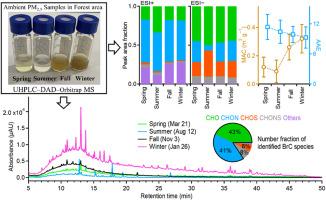秦岭森林大气中棕色碳气溶胶的分子特征
IF 7.3
2区 环境科学与生态学
Q1 ENVIRONMENTAL SCIENCES
引用次数: 0
摘要
对秦岭森林样地2021-2022年四季大气棕色碳(BrC)气溶胶进行了研究。采用超高效液相色谱仪、二极管阵列检测器和Orbitrap质谱仪对有机气溶胶的分子组成和光学性质进行了表征。有机气溶胶在365 nm波长处的质量吸收系数(MAC365,平均值为0.19±0.13 m2 g−1)低于世界范围内的平均值(约为0.04 ~ 2.8 m2 g−1),表明该森林环境中有机气溶胶的光吸收相对较低。BrC的光吸收表现出较强的季节变化,MAC365值秋冬季高于春夏季。它们对BrC的吸收大都很弱,而吸收能力随着人为污染的加剧而增加。共鉴定出51种主要BrC,以CHO和CHON种为主(84%),占BrC 300-450 nm总吸光度的14-39%。BrC的光学性质在很大程度上取决于其化学组成和分子结构,其中木质素类化合物和缩合芳烃是BrC的主要成分。不饱和度较低的脂类和蛋白类化合物可能是主要来源于生物质燃烧和生物排放的潜在BrC物种。本研究进一步加深了我们对人为-生物交叉大气中BrC气溶胶光学性质与其分子特性之间关系的认识。本文章由计算机程序翻译,如有差异,请以英文原文为准。

Molecular characteristics of brown carbon aerosols over a forest atmosphere in the Qinling region of central China
Atmospheric brown carbon (BrC) aerosols were investigated at a forest site in the Qinling Mountains region of central China across the four seasons of 2021–2022. The molecular composition and optical properties of organic aerosols were characterized using an ultrahigh performance liquid chromatograph coupled with a diode array detector and an Orbitrap mass spectrometer. The light absorption of organic aerosols was relatively low in this forest environment, as revealed by their lower mass absorption coefficients at 365 nm wavelength (MAC365, mean 0.19 ± 0.13 m2 g−1) compared with those of worldwide locations (approximately 0.04–2.8 m2 g−1). The light absorption of BrC exhibited strong seasonal variabilities, with higher MAC365 values in fall and winter than those in spring and summer seasons. They were mostly classified as very weakly absorbing BrC, while the absorption capacities were increased with enhanced anthropogenic pollution. A total of 51 major BrC species were identified and mostly composed of CHO and CHON species (84%), accounting for 14–39% of the total absorbance of BrC at 300–450 nm. The optical properties of BrC largely depended on their chemical composition and molecular structures, with lignin-like compounds and condensed aromatics being the major BrC components. The lipid- and protein-like compounds with lower unsaturation degrees could be the potential BrC species mainly originating from biomass burning and biological emissions. This study advances our knowledge on the connections of optical properties of BrC aerosols with their molecular characteristics in anthropogenic–biogenic intersection atmosphere.
求助全文
通过发布文献求助,成功后即可免费获取论文全文。
去求助
来源期刊

Environmental Pollution
环境科学-环境科学
CiteScore
16.00
自引率
6.70%
发文量
2082
审稿时长
2.9 months
期刊介绍:
Environmental Pollution is an international peer-reviewed journal that publishes high-quality research papers and review articles covering all aspects of environmental pollution and its impacts on ecosystems and human health.
Subject areas include, but are not limited to:
• Sources and occurrences of pollutants that are clearly defined and measured in environmental compartments, food and food-related items, and human bodies;
• Interlinks between contaminant exposure and biological, ecological, and human health effects, including those of climate change;
• Contaminants of emerging concerns (including but not limited to antibiotic resistant microorganisms or genes, microplastics/nanoplastics, electronic wastes, light, and noise) and/or their biological, ecological, or human health effects;
• Laboratory and field studies on the remediation/mitigation of environmental pollution via new techniques and with clear links to biological, ecological, or human health effects;
• Modeling of pollution processes, patterns, or trends that is of clear environmental and/or human health interest;
• New techniques that measure and examine environmental occurrences, transport, behavior, and effects of pollutants within the environment or the laboratory, provided that they can be clearly used to address problems within regional or global environmental compartments.
 求助内容:
求助内容: 应助结果提醒方式:
应助结果提醒方式:


